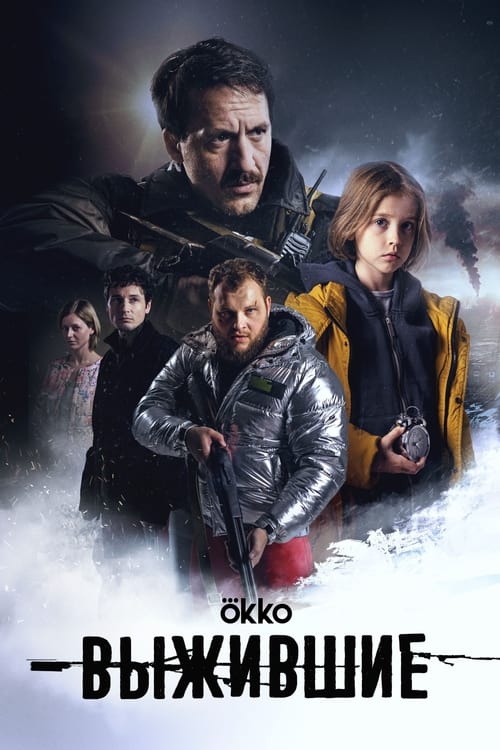
Ask Your Own Question
What is the plot?
In the year 2021, "Survivors" begins with a catastrophic event that wipes out a significant portion of the global population due to a mysterious virus. The story opens in a small town where we meet the main character, a resilient woman named Laura, who is trying to navigate the chaos that ensues as society begins to collapse. The initial scenes depict her frantic attempts to gather supplies while witnessing the panic and desperation of her neighbors. The emotional weight of loss and fear is palpable as she loses her husband to the virus early on, which sets her on a path of survival.
As the days pass, Laura encounters a group of survivors led by a man named Tom. This group is struggling to maintain order and find food. Tom is charismatic but has a ruthless streak, which becomes evident when he makes a tough decision to leave behind a member of their group who is too weak to continue. Laura is conflicted about this decision, feeling both the need for survival and the moral implications of abandoning someone in need. This moment establishes the tension between survival instincts and humanity that will be a recurring theme throughout the series.
The group decides to move to a nearby abandoned school, believing it to be a safer location. As they settle in, they begin to establish a new routine, scavenging for food and fortifying their defenses. During this time, Laura forms a bond with another survivor, a young woman named Mia, who has lost her family. Their friendship provides emotional support, but it also complicates Laura's feelings about the group's leadership and Tom's increasingly authoritarian approach.
Conflict arises when a rival group of survivors, led by a man named Greg, confronts Tom's group over territory and resources. A tense standoff occurs, and Tom's decision to escalate the situation leads to a violent confrontation. During the fight, Laura witnesses the brutality of survival as members of both groups are injured or killed. This event deeply affects her, causing her to question Tom's leadership and the moral choices they are making in their fight for survival.
In the aftermath of the confrontation, Laura and Mia discover a hidden cache of supplies in the school, which they decide to keep secret from Tom and the others. This decision is driven by their desire to protect themselves and ensure their survival, but it also creates a rift within the group. As tensions rise, Laura becomes increasingly aware of the dangers of Tom's leadership style and begins to consider the possibility of breaking away from the group.
As the story progresses, Laura's internal struggle intensifies. She grapples with her desire to protect Mia and her growing disillusionment with Tom. When Tom discovers that Laura and Mia have been hoarding supplies, he confronts them in a heated argument. Laura stands her ground, asserting that they need to look out for themselves, which leads to a fracture in the group's unity. Tom's reaction is aggressive, and he threatens to expel them from the group, heightening the stakes for Laura and Mia.
The situation escalates further when Greg's group launches a surprise attack on the school, seeking revenge for the earlier confrontation. In the chaos, Laura and Mia manage to escape, but not without witnessing the destruction of their makeshift home and the loss of several friends. This moment marks a turning point for Laura, as she realizes the fragility of their existence and the lengths they must go to survive.
After escaping, Laura and Mia find refuge in an abandoned cabin in the woods. They begin to forge a new life, relying on their resourcefulness and the skills they have developed. However, the emotional toll of their experiences weighs heavily on them. Laura struggles with guilt over leaving her former group behind, while Mia battles her own demons of loss and survival. Their bond deepens as they share their fears and hopes for the future.
As they settle into their new life, Laura and Mia encounter other survivors, including a man named Jake, who has a wealth of knowledge about the virus and its effects. He becomes a valuable ally, helping them understand the broader implications of the pandemic and the potential for rebuilding society. However, Jake's presence also introduces new complications, as he has his own agenda and secrets that threaten to disrupt their fragile peace.
The climax of the series occurs when Tom and his remaining followers track Laura and Mia down, leading to a final confrontation. Tom, fueled by anger and a desire for revenge, confronts Laura, accusing her of betrayal. The standoff is tense, with both sides armed and ready for a fight. Laura, now more confident and resolute, stands up to Tom, arguing that their survival should not come at the cost of their humanity. This moment of defiance is pivotal, as it showcases Laura's growth and her commitment to a different kind of survival.
In the ensuing chaos, a fight breaks out between the two groups. Laura and Mia fight alongside Jake, using their knowledge of the terrain to outmaneuver Tom's group. The battle is brutal, with injuries on both sides, but ultimately, Laura's group manages to gain the upper hand. In a final confrontation, Laura faces Tom one-on-one, and in a moment of clarity, she chooses to spare him, believing that violence will not lead to a better future.
The series concludes with Laura, Mia, and Jake standing together, looking out over the remnants of their world. They have survived the physical challenges, but the emotional scars remain. As they begin to plan for the future, the final scene leaves viewers with a sense of hope tempered by the reality of their situation, emphasizing the ongoing struggle for survival in a changed world.
What is the ending?
In the ending of the 2021 TV show "Survivors," the main characters face the culmination of their struggles against the harsh realities of a post-apocalyptic world. The group confronts their internal conflicts and the external threats that have plagued them throughout the series. Ultimately, they must make difficult choices that lead to significant sacrifices, shaping their fates and the future of their community.
As the final episodes unfold, the tension escalates. The group, led by the resilient and determined character, faces a dire threat from a rival faction that seeks to take control of their resources. The characters grapple with their fears, loyalties, and the moral dilemmas of survival. In a climactic confrontation, they band together to defend their home, showcasing their growth and unity.
In the end, some characters find closure, while others face tragic outcomes. The leader sacrifices themselves to ensure the safety of the remaining group members, leaving a profound impact on their lives. The surviving characters are left to navigate their new reality, carrying the weight of their losses but also the hope of rebuilding.
Expanded Narrative:
The final episodes of "Survivors" begin with a palpable tension in the air. The camera pans over the makeshift camp where the group has found refuge, the remnants of their previous lives scattered around them. The sun sets, casting long shadows that symbolize the uncertainty looming over them. The leader, a strong-willed individual named Alex, gathers the group for a meeting. Their faces are etched with worry, each member aware that their fragile peace is about to be shattered.
As they discuss the growing threat from a rival faction, the atmosphere is thick with anxiety. Alex's voice is steady, but there's a flicker of fear in their eyes. They emphasize the importance of unity, urging everyone to prepare for the worst. The camera captures the determination in their expressions, but also the underlying dread of what may come.
The next scene shifts to the rival faction, a ruthless group led by a charismatic but dangerous figure named Marcus. The contrast between Marcus's confident demeanor and the group's vulnerability is stark. He rallies his followers, promising them power and resources, igniting their desire for conquest. The tension builds as the two groups inch closer to an inevitable confrontation.
Back at the camp, the characters engage in personal moments that reveal their internal struggles. Sarah, a compassionate member of the group, tends to the wounded, her hands trembling as she bandages a friend's injury. Her eyes reflect the weight of responsibility she feels, knowing that every decision could mean life or death. Meanwhile, Jake, a former soldier, sharpens his weapons, his face a mask of stoicism, but inside, he wrestles with the ghosts of his past.
As night falls, the rival faction launches a surprise attack. The scene is chaotic, filled with the sounds of shouting and the clash of metal. The camera captures the frantic energy as the group fights back, showcasing their resilience and teamwork. Alex leads the charge, their heart pounding with adrenaline, driven by the need to protect their family.
In a pivotal moment, Alex finds themselves face-to-face with Marcus. The tension is electric as they exchange heated words, each representing their respective ideologies of survival. The confrontation escalates into a physical struggle, and in a moment of desperation, Alex makes a selfless decision. They push Marcus away from a vulnerable group member, sacrificing their own safety in the process.
The scene shifts to the aftermath of the battle. The camp is in ruins, and the surviving members gather to mourn their losses. The camera lingers on Sarah, who clutches a photo of Alex, tears streaming down her face. The emotional weight of their sacrifice hangs heavy in the air, a reminder of the cost of survival.
In the final moments, the remaining characters stand together, united yet changed. They look out over the horizon, the sun rising in the distance, symbolizing a new beginning. Each character carries the scars of their experiences, but there's a flicker of hope in their eyes. They vow to honor Alex's memory by rebuilding their community, determined to create a better future despite the challenges ahead.
The series concludes with a poignant sense of resilience, highlighting the enduring spirit of humanity in the face of adversity. The fate of each character is intertwined with the legacy of their leader, shaping their paths as they navigate the uncertain world that lies before them.
Is there a post-credit scene?
The 2021 series "Survivors" does not feature a post-credit scene. The show concludes its narrative without any additional scenes after the credits roll. The final moments of the series focus on the resolution of the main characters' arcs, emphasizing their struggles and growth throughout the season. The absence of a post-credit scene allows the audience to reflect on the journey of the characters and the themes of survival and resilience that permeate the series.
How do the relationships between the characters evolve throughout the series?
The relationships in 'Survivors' are complex and evolve significantly as the series progresses. Initially, characters may be wary of each other, but as they face life-and-death situations together, bonds are formed. For instance, the dynamic between the leader and the reluctant follower shifts from distrust to a deep mutual respect, while romantic tensions develop between two characters who find solace in each other amidst chaos.
What challenges do the characters face in their daily survival?
In 'Survivors', the characters face numerous challenges that test their resilience and resourcefulness. They must navigate the harsh realities of a post-apocalyptic world, including finding food and clean water, building shelter, and defending themselves against threats from other survivors and the environment. Each character's approach to these challenges reveals their strengths and weaknesses, showcasing their emotional struggles and growth.
What specific events lead to the breakdown of society in the show?
The breakdown of society in 'Survivors' is depicted through a series of catastrophic events, including a viral outbreak that decimates the population, followed by widespread panic and the collapse of governmental structures. Flashbacks reveal the chaos of the initial outbreak, showcasing the fear and confusion that gripped communities, leading to a rapid descent into lawlessness and survivalism.
What are the key motivations driving the main characters' actions?
Each main character in 'Survivors' is driven by distinct motivations that shape their actions. For example, one character is motivated by the desire to protect their family at all costs, while another seeks redemption for past mistakes. These motivations often clash, leading to intense conflicts and moral dilemmas that force characters to confront their values and priorities in a world where survival often comes at a cost.
How do the characters cope with loss and grief throughout the series?
Coping with loss and grief is a central theme in 'Survivors'. Characters experience profound losses, whether through the death of loved ones or the disintegration of their former lives. The show poignantly depicts their emotional journeys, showcasing moments of vulnerability, anger, and despair. Some characters find solace in forming new connections, while others struggle to move on, illustrating the varied ways individuals process grief in a survival context.
Is this family friendly?
The 2021 TV show "Survivors" contains several elements that may not be suitable for children or sensitive viewers. Here are some potentially objectionable or upsetting aspects:
-
Violence and Conflict: The series features scenes of physical confrontations and violence, which may be intense and distressing for younger audiences.
-
Survival Situations: Characters face life-threatening situations, including injuries and the struggle for basic necessities, which can evoke feelings of fear and anxiety.
-
Emotional Trauma: The characters deal with significant emotional distress, including loss, grief, and the psychological impact of survival, which may be heavy for sensitive viewers.
-
Mature Themes: The show explores themes of betrayal, moral dilemmas, and the darker aspects of human nature in extreme circumstances, which may be challenging for younger viewers to process.
-
Isolation and Despair: The portrayal of isolation and the emotional toll it takes on characters can be unsettling, as it highlights feelings of hopelessness and despair.
These elements contribute to a narrative that, while compelling, may not be appropriate for all audiences, particularly children.











































